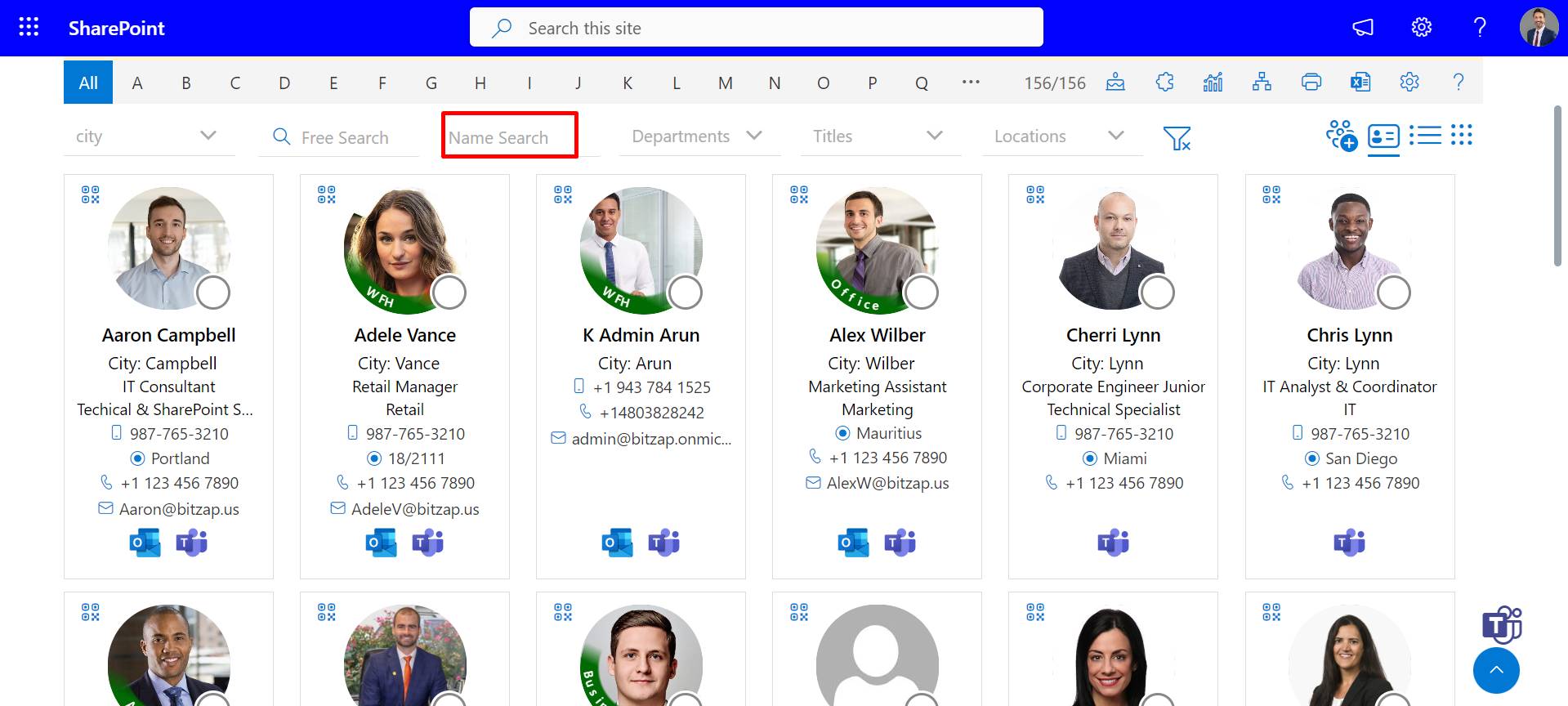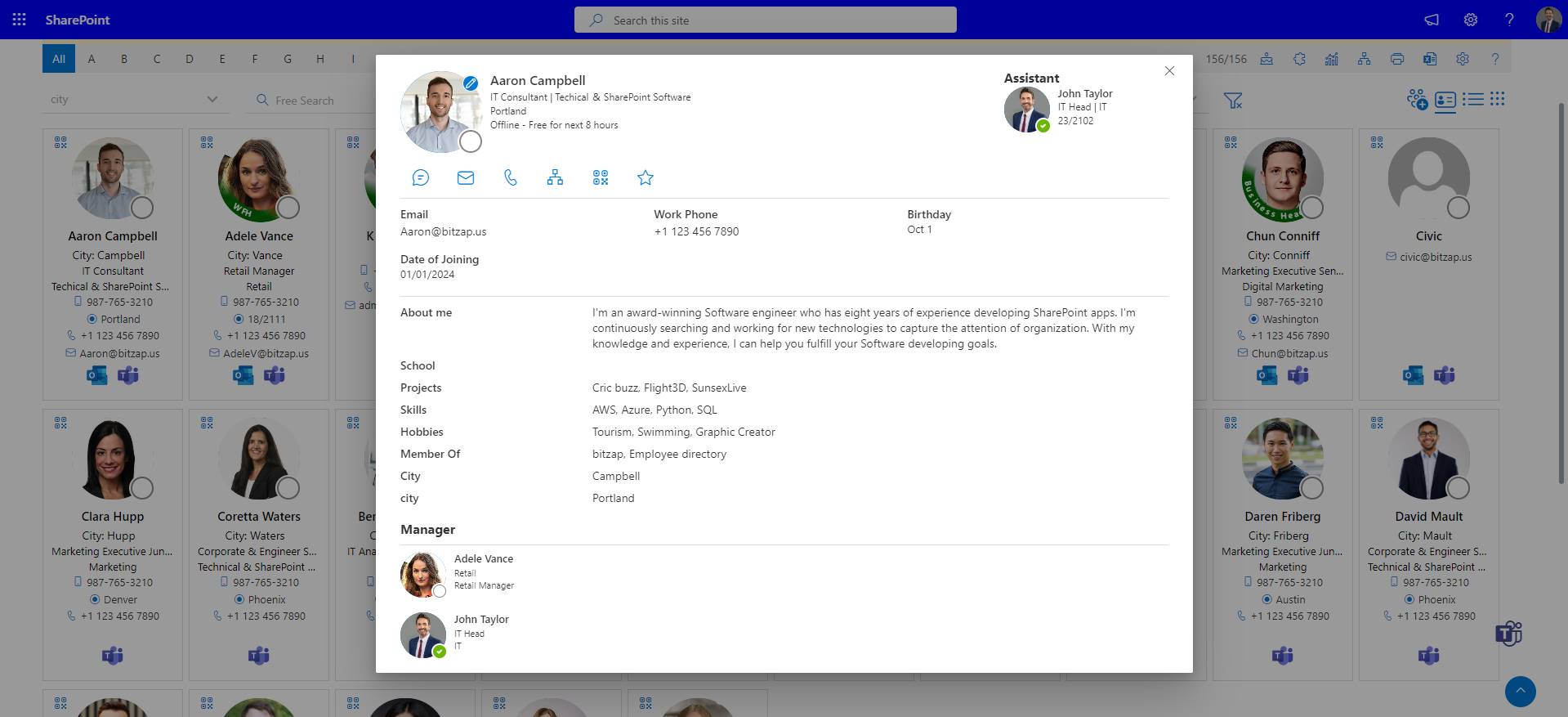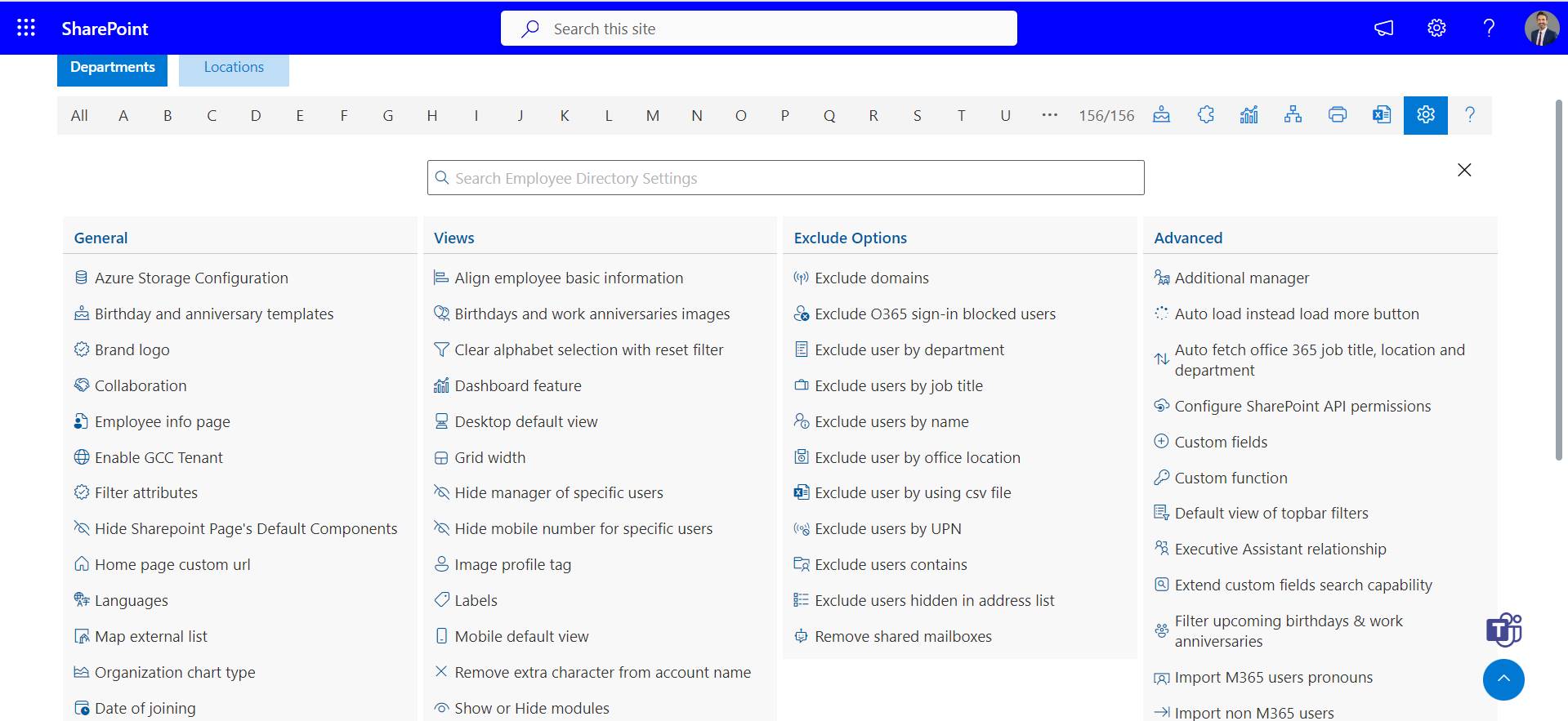Employee Directory Software
Organizations may effectively manage and access employee data with the help of employee directory software, which provides a comprehensive solution that promotes cooperation, faster communication, and corporate transparency.
What is an employee directory?
An employee directory is an organization’s centralized database or online platform containing essential employee information. This directory typically includes names, contact information, job titles, department, profile photos, etc.,
Employee directory software serves various purposes within an organization, including facilitating communication, enabling collaboration, and helping employees find and connect with colleagues.
They are often accessible to all employees within the organization and may be available in both digital and print formats.
In larger organizations, employee directories can be particularly valuable for helping employees navigate the organizational structure and identify key contacts for specific projects or tasks.
What are the features of Employee Directory software?
The features of best Employee Directory Software can vary depending on the specific needs and functionalities required by an organization.
Here are some common features found in employee directory app:
Search functionality:
Search functionality is a fundamental feature of an employee directory, providing users with a quick and efficient way to locate specific individuals within an organization.
This feature allows users to enter search queries, such as a person’s name, job title, department, or any other relevant criteria, and receive instant results matching their search criteria.
By leveraging search functionality, employees can easily find colleagues they need to communicate or collaborate with, regardless of the size of the organization or the complexity of its structure.
Whether it’s locating a department head, finding a subject matter expert, or identifying a team member for a project, the search functionality streamlines the process, saving time and enhancing productivity.
Additionally, advanced search capabilities may include filters and sorting options to further refine search results, ensuring users can quickly pinpoint the exact information they’re looking for within the employee directory app.

Employee Profiles:
Employee profiles are a cornerstone feature of an Ofiice 365 employee directory, offering comprehensive snapshots of each individual within an organization.
These profiles typically encompass vital details such as contact information, job title, department, and reporting structure, providing colleagues with essential context for effective communication and collaboration.
By centralizing this information in easily accessible profiles, the Microsoft 365 employee directory fosters transparency and connectivity across the organization, empowering employees to connect with the right people efficiently.
The ability to customize profiles with relevant data ensures that the directory remains adaptable to the evolving needs and dynamics of the organization, facilitating smoother workflows and fostering a culture of collaboration and knowledge sharing.

Contact Information:
Contact Information feature of an employee directory app serves as a vital resource for facilitating communication and connectivity within an organization.
By providing readily accessible email addresses, phone numbers, office locations, and other contact details for each employee, the directory streamlines the process of reaching out to colleagues for collaboration, inquiries, or assistance.
Whether employees need to coordinate on a project, seek guidance from a supervisor, or simply touch base with a coworker, having contact information readily available fosters seamless communication and enhances productivity.

Organization Chart:
Organization Chart feature provides a visual representation of the hierarchical structure and reporting relationships within an organization. This feature offers employees a clear understanding of the organizational hierarchy, illustrating how different departments, teams, and individuals are interconnected.
By displaying reporting lines and managerial roles, the organization chart helps employees identify key decision-makers, understand the chain of command, and navigate the organizational structure more effectively.
This visual tool not only aids in clarifying roles and responsibilities but also facilitates communication and collaboration by providing insight into who to contact for specific matters or approvals.

Security and Privacy:
Security and Privacy features are paramount for safeguarding sensitive information and ensuring compliance with data protection regulations.
This feature encompasses various measures to protect employee data from unauthorized access, misuse, or breaches.
It may include user authentication mechanisms such as login credentials, multi-factor authentication, or single sign-on to verify the identity of users accessing the directory.
Additionally, access controls and permissions settings are implemented to restrict access to specific employee information based on roles or responsibilities within the organization.
By prioritizing security and privacy, the employee directory app instills trust among employees regarding the confidentiality and integrity of their personal information, fostering a culture of accountability and respect for privacy within the organization.

Advanced Search Filters:
Advanced Search Filters feature enhances the efficiency and precision of locating specific individuals or groups within an organization. This feature empowers users to refine their search queries by applying various criteria or filters beyond basic keyword searches.
Users can narrow down search results based on parameters such as department, job title, location, skills, or even specific project involvement.
By providing these advanced filtering options, the SharePoint employee directory enables users to pinpoint the exact information they are seeking, thereby saving time and effort in the search process.
Whether it’s identifying subject matter experts, locating colleagues with particular skills, or assembling project teams with specific qualifications, advanced search filters offer a highly tailored and targeted approach to accessing employee information.
The flexibility and customization afforded by this feature accommodate diverse user needs and preferences, ensuring that individuals can personalize their search queries to align with their specific requirements.

Analytics and Reporting:
This feature provides valuable insights into how the directory is utilized and helps organizations optimize its effectiveness.
Through analytics, administrators can track key metrics such as the number of searches performed, most frequently viewed employee profiles, popular search queries, and trends in directory usage over time.
These insights enable organizations to identify patterns, understand user behavior, and make data-driven decisions to improve the directory’s usability and relevance.
Additionally, reporting capabilities allow administrators to generate comprehensive reports on directory activity, which can be used for performance evaluation, compliance audits, or strategic planning purposes.
By leveraging analytics and reporting, organizations can continuously refine and enhance the employee directory app to better meet the needs of users, streamline workflows, and foster a more collaborative and connected workplace culture.

What are the benefits of using an Employee Directory application for your business?
Employing an Employee Directory application can bring numerous advantages to a business, including:
- Improved Communication: With easy access to the employee contact list, employees can quickly reach out to colleagues, fostering better communication and collaboration across departments and teams.
- Increased Efficiency: Employees spend less time searching for contact details or trying to identify the right person to contact, leading to increased productivity and smoother workflow processes.
- Enhanced Collaboration: The directory helps employees identify subject-matter experts, project collaborators, or team members, facilitating collaboration on projects and tasks.
- Organizational Transparency: By providing visibility into the organizational structure and reporting relationships, the directory promotes transparency and clarity, helping employees understand how the business functions and who to turn to for assistance or guidance.
- Faster Onboarding: New employees can quickly familiarize themselves with their colleagues, supervisors, and key contacts, accelerating the onboarding process and enabling them to integrate into the organization more smoothly.
- Support for Remote Work: In remote or distributed work environments, where face-to-face interactions are limited, the directory becomes even more valuable for connecting remote teams and facilitating virtual collaboration.
- Centralized Information Hub: The directory serves as a centralized repository for employee information, making it easy to update and access essential details such as contact information, job titles, and departmental affiliations.
- Data-Driven Decision-Making: Analytics and reporting features in some employee directories provide insights into usage patterns, employee engagement, and communication trends, empowering businesses to make data-driven decisions to optimize their workforce and operations.
- Compliance and Security: Employee directories can be configured with robust security measures and access controls to protect sensitive employee information and ensure compliance with data privacy regulations.
- Scalability and Adaptability: As businesses grow and evolve, employee directories can scale to accommodate changes in workforce size, structure, and technology requirements, supporting the organization’s growth and adaptability.
Utilizing an Microsoft employee directory can lead to increased efficiency, better communication, enhanced collaboration, and improved organizational transparency, ultimately contributing to the success and effectiveness of the business.
What employee information will be stored in the Employee Directory application?
An employee directory application serves as a comprehensive repository of essential information about individuals within an organization, facilitating seamless communication, collaboration, and organizational transparency.
Within this centralized platform, various key details about employees are stored, ranging from basic contact information to more nuanced aspects such as job titles, reporting structures, and skills.
The specific employee information stored in an Office 365 employee directory can vary depending on the organization’s needs, policies, and the capabilities of the directory software. Typical data elements that may be included in an employee directory app are:
- Name: Full name of the employee.
- Contact Information: Email address, phone number, office location, and possibly alternative contact methods.
- Job Title: The employee’s position or job title within the organization.
- Department/Team: The department or team to which the employee belongs.
- Profile Picture: An optional photo of the employee for identification purposes.
- Location: Physical location or office of the employee.
- Skills and Expertise: Information about the skills, qualifications, certifications, or areas of expertise possessed by the employee.
- Availability: Information about the employee’s working hours, availability for meetings, or out-of-office status.
- Emergency Contacts: Contact details for emergencies, such as next of kin or designated emergency contacts.
- Custom Fields: Any additional custom fields or attributes specific to the organization’s needs, such as employee ID numbers, project involvement, or personal preferences.
Organizations need to consider data privacy and security when determining which employee information to include in the directory system. Confidential or sensitive information should be handled with care and only shared on a need-to-know basis, in compliance with relevant data protection regulations and internal policies.
Why should employee directory software be a part of modern HR strategy?
Employee directory software should be a cornerstone of modern HR strategy for several compelling reasons:
- Enhanced Communication and Collaboration: Employee directory software facilitates seamless communication by providing easy access to contact information and organizational structures. It enables employees to quickly find and connect with colleagues, fostering collaboration across teams and departments.
- Improved Employee Experience: By centralizing important information such as contact details, job titles, and reporting structures, employee directory app empowers individuals to navigate the organization more efficiently. This enhances the employee experience by reducing friction in accessing information and resources.
- Efficient Onboarding and Offboarding Processes: During onboarding, new employees can utilize the directory to familiarize themselves with their team members, managers, and other key contacts. Similarly, during offboarding, HR can efficiently update or remove employee profiles, ensuring a smooth transition when employees leave the organization.
- Streamlined HR Operations: Employee directory app automates many administrative tasks related to managing employee information, such as updating contact details or organizational changes. This frees up HR resources to focus on strategic initiatives and higher-value activities.
- Support for Remote and Distributed Teams: In today’s increasingly remote and distributed work environments, SharePoint employee directory software becomes even more essential for connecting dispersed teams. It provides a centralized platform for employees to stay connected regardless of their physical location.
- Data-Driven Decision Making: Employee directory software often includes analytics and reporting capabilities that provide insights into usage patterns and employee engagement. HR can leverage these insights to make data-driven decisions about organizational structure, resource allocation, and employee engagement initiatives.
- Compliance and Security: Modern employee directory app prioritizes data security and compliance with regulations such as GDPR or HIPAA. By implementing robust security measures and access controls, organizations can protect sensitive employee information and ensure compliance with data privacy laws.
- Scalability and Adaptability: As organizations grow and evolve, employee directory software scales seamlessly to accommodate changes in workforce size, structure, and technology requirements. It can adapt to the needs of the organization, whether it’s expanding to new locations, integrating with other systems, or supporting diverse workforce models.
Employee directory software plays a crucial role in modern HR strategy by facilitating communication, enhancing employee experience, streamlining HR operations, supporting remote work, enabling data-driven decision-making, ensuring compliance and security, and adapting to organizational growth and change.
By incorporating Microsoft employee directory software into their HR toolkit, organizations can effectively manage their workforce and drive success in today’s dynamic business landscape.
Frequently Asked Questions
An employee directory application is a software tool or platform designed to centralize and manage information about employees within an organization.
It provides a convenient and accessible way for employees to search for and find contact information, organizational hierarchies, and other relevant details about their colleagues.
Employee directory applications typically include features such as search functionality, employee profiles, contact information, organizational charts, and sometimes additional capabilities like integration with other systems or advanced search filters.
These applications can be web-based, mobile-friendly, or integrated into existing intranet or communication platforms, offering flexibility in how employees’ access and interact with the directory.
Creating an employee directory involves several steps, and the specific process may vary depending on your organization’s needs and the tools available.
Here’s a general guide to help you create an employee directory:
- Gather Employee Information: Collect relevant information about your employees, including names, contact details (email addresses, phone numbers), job titles, departments, reporting structures, and any other relevant details you want to include in the directory.
- Design the Directory Structure: Determine how you want to organize and structure the directory. Consider categorizing employees by department, job title, or any other relevant criteria. Decide which fields you’ll include in the directory and how you’ll display the information.
- Input Employee Data: Enter the employee information you gathered into the chosen platform or tool. If using a spreadsheet, create columns for each data field (e.g., name, email, department) and enter the information accordingly. If using software, follow the provided instructions for adding employee profiles.
- Customize and Format: Customize the appearance and format of the directory to meet your organization’s branding and design preferences. Add headers, labels, or color schemes to make the directory visually appealing and easy to navigate.
- Review and Update: Review the directory to ensure that all employee information is accurate and up to date. Regularly update the directory as employees join, leave, or change roles within the organization.
- Share the Directory: Determine how you’ll share the employee directory with employees. You could distribute it via email, share it on your organization’s intranet or internal portal, or provide access through dedicated directory software. Ensure that employees know how to access and use the directory effectively.
By following these steps, you can create an employee directory that meets the needs of your organization and helps employees connect and collaborate more effectively.
Choosing the right employee directory software for your organization requires careful consideration of several factors to ensure that the solution aligns with your specific needs and objectives. Here’s a step-by-step guide to help you make an informed decision:
Identify your requirements: Start by identifying the key requirements and objectives for implementing employee directory software in your organization. Consider factors such as the size of your organization, the complexity of your organizational structure, the need for integration with other systems, and any specific features or functionalities you require.
Evaluate features: Research and evaluate employee directory software solutions based on their features and capabilities. Look for features such as customizable employee profiles, search functionality, organizational chart visualization, mobile access, employee self-service capabilities, and integration with other systems such as HRIS or collaboration tools.
Consider scalability: Choose a solution that can scale with your organization’s growth and evolving needs. Consider factors such as the number of employees the software can support, the ability to add new features or modules as needed, and the scalability of the pricing model.
Assess ease of use: Select employee directory software that is intuitive and user-friendly for both administrators and employees. Consider factors such as ease of navigation, clarity of user interface, and availability of training and support resources to help users get up to speed quickly.
Check integration capabilities: Ensure that the employee directory software can seamlessly integrate with other systems and tools used within your organization, such as HRIS, email clients, calendar applications, and collaboration platforms. Integration capabilities ensure smooth data exchange and workflow automation across different systems.
Review security and compliance: Prioritize security and compliance features to protect sensitive employee information and ensure compliance with relevant regulations such as GDPR or CCPA. Look for features such as role-based access controls, data encryption, audit trails, and compliance with industry standards for data privacy and security.
Evaluate vendor reputation and support: Research the reputation and track record of potential software vendors or providers. Look for customer reviews, testimonials, case studies, and references from organizations similar to yours. Consider factors such as vendor reliability, responsiveness to support inquiries, ongoing maintenance and updates, and the availability of user communities or forums for knowledge sharing.
Assess cost and ROI: Consider the cost of implementing and maintaining the employee directory software, including licensing fees, implementation costs, ongoing support and maintenance fees, and any additional costs for customization or integration. Evaluate the potential return on investment (ROI) based on the expected benefits such as improved communication, productivity gains, and reduced administrative burden.
By following these steps and carefully evaluating your options, you can choose the right employee directory software that meets your organization’s needs and helps you achieve your objectives effectively.
Employee directory software can be secure if designed and implemented with appropriate security measures to protect sensitive employee information. Here are some key security considerations for employee directory software:
Data Encryption: Employee directory software should encrypt sensitive data both in transit and at rest to prevent unauthorized access or interception. Encryption ensures that even if data is intercepted, it remains unreadable without the appropriate decryption key.
Access Controls: Implement role-based access controls (RBAC) to restrict access to employee information based on user roles and permissions. This ensures that only authorized users have access to sensitive data, and access rights are granted on a need-to-know basis.
User Authentication: Require strong authentication mechanisms, such as passwords, multi-factor authentication (MFA), or single sign-on (SSO), to verify the identity of users accessing the employee directory software. This helps prevent unauthorized access by ensuring that only authenticated users can log in.
Audit Trails: Maintain detailed audit trails that track user activities within the employee directory software, including logins, access attempts, modifications to employee records, and other relevant actions. Audit trails help organizations monitor user behavior, detect suspicious activities, and investigate security incidents.
Data Masking: Employ data masking techniques to conceal sensitive information, such as social security numbers, salary details, or personal contact information, from unauthorized users. Data masking ensures that only users with appropriate privileges can view sensitive data, while protecting employee privacy.
Secure Transmission: Ensure that employee directory software uses secure communication protocols, such as HTTPS, to encrypt data transmitted between users’ devices and the software servers. Secure transmission prevents data interception or tampering during transit over untrusted networks.
Regular Security Updates: Keep the employee directory software up-to-date with the latest security patches, updates, and bug fixes to address vulnerabilities and mitigate security risks. Regularly updating the software helps protect against known security threats and ensures that security measures remain effective over time.
Compliance with Regulations: Ensure that the employee directory software complies with relevant data protection regulations, such as GDPR, CCPA, HIPAA, or other industry-specific requirements. Compliance with regulations helps organizations maintain data privacy, protect employee rights, and avoid potential legal or regulatory consequences.
By implementing these security measures, employee directory software can provide a secure environment for managing and accessing employee information, protecting sensitive data from unauthorized access, and maintaining confidentiality, integrity, and availability.
Schedule a free personalized 1:1 demo
By proceeding, you accept Cubic Logics’s terms and conditions and privacy policy






Start Your Free Experience
By proceeding, you accept Cubic Logics’s terms and conditions and privacy policy






Schedule a free personalized 1:1 demo
By proceeding, you accept Cubic Logics’s terms and conditions and privacy policy






Try It Free, No Obligation
By proceeding, you accept Cubic Logics’s terms and conditions and privacy policy






Request of the Free License
By proceeding, you accept Cubic Logics Terms and Conditions and Privacy Policy
Offer is expiring soon!
Fill in your details below to receive your personalized coupon code.
Start Your Free Experience
By proceeding, you accept Cubic Logics’s terms and conditions and privacy policy






